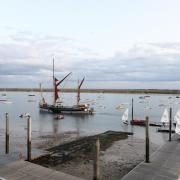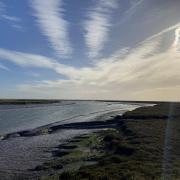How Essex Wildlife Trust are working to protect this coastal ecosystem engineer
Away from the crashing tides and strong currents, in the sheltered muddy respite that Essex’s estuaries offer, lives an unassuming ecosystem engineer: the native oyster.
Native oysters have a rounded, rough shell with overlapping ridges across their knobbly surface – reminiscent of the growth rings visible in a tree’s trunk. Coloured with bruised shades of yellow, brown and green, each native oyster appears to exhibit its unique fingerprint on the rounded half of its two-part shell. You’d be forgiven if you are wondering how this humble mollusc, which lacks even a central nervous system, could be deemed an ecosystem engineer. Yet, these iconic staples of the Essex coastline provide a valuable service to the underwater world.
Filter feeders
The most important service that native oysters provide to the coastal ecosystem is their ability to purify water. Like whale sharks, manta rays and tropical giants in faraway seas, oysters are filter feeders. This means that they pump large volumes of water through their little bodies, feeding on tiny plankton, algae and other water-borne nutrients that get trapped in the mucus of their gills. The small-but-mighty native oyster can filter up to 200 litres of water per day, proving that you don’t need to be whale-sized to make an impact on your surroundings.
Oysters are the kidneys of the coast; just as human kidneys filter blood to keep our internal environment healthy, native oysters filter the surrounding waters to maintain the health of their habitat. By filter feeding, oysters are removing excess organic matter like nitrogen and phosphorus, which in large quantities can trigger algal blooms, causing oxygen levels to deplete and fatalities to marine life. Thanks to the oyster’s filtering process, waters become clearer and sunlight can shine through the less-murky waters. Vegetation such as seagrass can grow on the newly lit seabed, providing further habitat and food sources for creatures like seaworms and crabs.

Oyster reefs
While native oysters are hard at work filtering the waters they live in, they also provide another valuable service to their coastal companions. Oysters begin life as larvae, floating freely in search of a rough surface to grow upon. But native oysters like to stick together, literally. Often, larvae will settle on adult oysters, and these oyster colonies form reef-like habitats that support biodiversity.
Sea settlers like mussels, barnacles and sea anemones enjoy the new residential area to live upon. For other species like eels, sponges, crabs and fish, the oyster bed is a foraging hotspot, as well as a place of shelter when evading prey. An oyster reef is also an ideal nursery for juvenile species looking to curiously explore the shallow surroundings with the safety of the reef nearby.
Mighty molluscs
Not only can oysters support hundreds of species, from crustaceans creeping along the rocky shallows to the sea birds soaring above, but their impact reaches far beyond the marine environment. As an iconic species of Essex, these creatures are part of a rich cultural heritage for the fishing community, dating back to the Roman period when they were first popularised.
However, their cultural and economic significance is secondary to the role they play environmentally. Oyster reefs serve as natural coastal buffers, absorbing the energy of crashing waves upon our shorelines and reducing coastal erosion. Through their filtration system, oysters also help to contain and capture greenhouse gases like carbon, acting as a nature-based solution to climate change.

Restoring native oysters
Sadly, native oysters have declined by 95 per cent since the 1850s. Overfishing, invasive species, disease and pollution have all contributed to this loss. Luckily, the southeast boasts the highest remaining population of native oysters, and Essex Wildlife Trust is working in partnership with local fishermen, conservationists and government regulators to conserve this important species through the Essex Native Oyster Restoration Initiative (ENORI).
In 2013, 284km2 of the Blackwater, Crouch, Roach and Colne Estuaries was designated a Marine Conservation Zone, and so began the largest marine restoration project in the UK by area. By working collaboratively, the Trust hopes to recover self-sustaining populations of these culturally, economically and environmentally valuable native oysters.
Recently, the Trust has been working with Blue Marine Foundation to deliver the ENORI project, using oyster cages at Brightlingsea Marina as educational tools for school children to learn about these native species, their value to the environment and other marine species in Essex’s waters.
Find out more at essexwt.org.uk



























